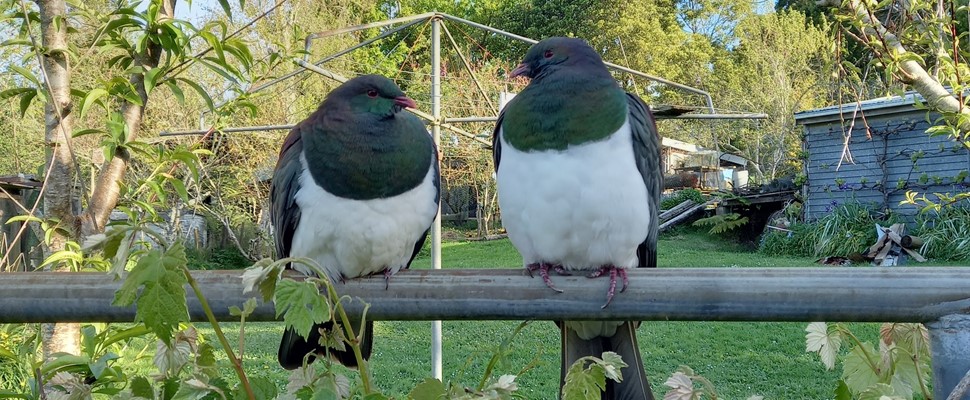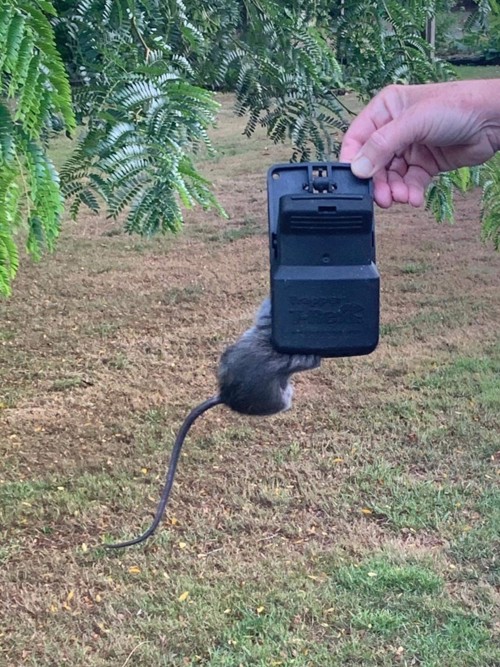
Animal pest control in your garden
Maintaining biodiversity and plant success through pest control
I want to help protect native plants and animals, why is pest management so important?
Predatory pest animals impact birds by eating eggs and young, and sometimes attacking adults while they are sitting vulnerable on a nest. They also affect populations of other native animals such as bats, insects, geckos and skinks. Some pest animals impact plants too. Pests eat fruits and seeds, but also flowers and new shoots. Pests browsing on new growth can eventually affect a mature tree to the point of death.
Many native plants evolved with birds. They rely on fruit consumption by birds and the resulting fermentation process within the gut to be viable for germination, and for dispersal away from the parent plant. When fruit is instead eaten by rats or mice, often the flesh is consumed leaving the seed behind. The seed may be damaged, or if ingested gut conditions do not allow the seed to germinate after exiting the animal. In some cases, seeds simply pass through the gut too quickly for sufficient fermentation to occur. Pests can affect all points in the lifecycle of plants, resulting in species that may become reclassified as ‘threatened’.
Some plants with larger fruits can only be dispersed by Kererū. Other native birds that had a mouth gape wide enough to swallow the fruit have now become extinct. The fruits of these plant species such as Tawa and Taraire require the process of gut fermentation to grow. Pest control is therefore important to not only ensure breeding success of Kererū, but also to ensure that flowers survive long enough to be pollinated and produce fruit, and to ensure that the fruits don’t get eaten by rats before the Kererū can get to them.
By conducting pest control, we can assist many aspects of biodiversity and natural ecosystem sustainability. From plant health to insect survival (and therefore pollination, and alternative food sources for birds), to bird life and so seed dispersal and growth.
What are the main pests I need to control?
Pest animals in the Regional Pest Management Plan include possums, rats, mice and mustelids (ferrets, stoats and weasels). These each impact plant success and therefore biodiversity in their own way.
How do I control these pests, what do I need to get started?
You first need to decide what method will work for your lifestyle and your space. Do you prefer baiting or trapping? What animals would you like to target?
Once you have decided this, see below for tips for conducting effective pest control here.
Apart from looking after native species why else should I think about pest control?
Pests like rats and possums eat lemons and other citrus, feijoas, and rosebuds. With any of these plants in a garden pest control is worth considering. Pests will also be attracted to compost bins and chicken and duck enclosures.
I live in the city, isn’t pest control something for the bush and forest?
Pests don’t respect property boundaries, or urban/rural boundaries. Urban areas have a unique advantage over rural areas due to the natural ‘grid’ system provided by the very nature of property spacing in urban environments. If each property has a trap for pests, this will contribute to a blanket of pest control across an urban area, with spacings often accidentally in line with recommendations within the Pest Animal Control Guidelines for the Auckland Region. Visit https://www.tiakitamakimakaurau.nz/ for advice on where to start for Aucklanders wanting to get into trapping, as you can then start by utilising best practise methods right away.

How to effectively trap pests
Below is a mixture of tips and tricks both from Auckland Council recommendations and suggestions that have come from members of the trapping community. There is no one correct way to control pests. They are intelligent and learn to be wary of certain things and can pass these behaviours to others. This means it is important that we constantly change our mode of attack, so that they are caught unawares, literally!
Most pest control hardware can be obtained at your local hardware stores.
Baiting:
Popular bait stations include Philproof stations for rats and possums, or pied piper rat bait stations.
There are many different baits on the market to target possums, rats and mice. There are a few key points to remember:
- Baits are poisons designed to kill. Keep in mind any curious children or animals when thinking about placement and storage.
- Use gloves and wash hands thoroughly after handling. Do not use the gloves for anything else.
- When exposed to the elements, bait will go off over time. Wax blocks are more protected. Store bait in an airtight container. In bait stations it is better to enclose baits in a plastic bag which animals need to chew through (and thus ingest some) and protect the pellets from humidity as much as possible.
- Refill bait stations no more frequently than once every 5 days. Poisons take some time to take effect, and you don’t want to be wasting bait on an animal that has already been poisoned.
Rats & Mice:
Popular traps are the snap trap types or T-Rex traps.
Placement:
- Place traps or bait stations 25 – 50m apart.
- Place traps or stations under a house, in ceilings, in warm dry spaces like sheds, near a waterway, or along a fence line/retaining wall. They like to be able to run between areas using ‘shelter’ rather than being in the open.
Lure:
- Peanut butter or Nutella. You can smear these on bait bags to increase attraction. To change it up you can mix with kibbled wheat/oats/other grains.
- Using a lighter, melt a small piece of cheese to the trigger mechanism
- Small piece of dog-treat jerky
Tips:
- Attach traps to a board to place further into spaces under a house or in a ceiling. If not attached to a board, tie the trap to an immovable object to help prevent an animal running away with the trap.
- Build a tunnel around rat traps to make them more attractive. This can be as simple as a board base with rigid plastic stapled tunnel-fashion on top.
- Attach wax bait blocks via a nail to existing posts or wood, using cut milk bottles to protect it from the weather.
- You can make your own bait station using an ice-cream container. Cut a C-shaped hole in the edge of the tub for an entry hole. Think about water if it is out in the open – you may need to fashion a kind of awning to prevent rain getting in.
Possums:
Popular traps include the Trapinator, Timms trap or Flipping Timmy.
Placement:
- At the base of an attractive tree or in a grove of trees e.g. in an orchard, the base of a large palm or large natives, at least 1 metre above the ground
- Near waterways that they would use to drink from, or a pathway that they might use e.g. through a grove of trees
Lure:
- A cut apple or carrot with cinnamon. Rub on the cut side of the apple.
- Feijoas, citrus or other fruit they are enjoying
- Mix flour and water with curry powder, cinnamon or aniseed and smear the paste leading to the trap
Tips:
- Attach traps to a board so that it is elevated from pets and easier to move around rather than attaching directly to a tree.
Mustelids:
Popular traps include the DoC150 – 250 series, and live traps.
Placement:
- On flat ground so that the trap is stable and doesn’t rock
- Near a waterway, or along a fence line/retaining wall. They like to be able to run between areas using ‘shelter’, rather than being in the open.
Lure:
- A whole, raw egg which also functions as a visual lure. When changing this, throw it into the bushes nearby to attract mustelids to the area of the trap
- Fish/salmon (raw or cooked)
- Meat scraps from dinner (raw or cooked)
- Possum or rabbit meat from recent catch
- Mayonnaise mixed with salmon oil. This acts as a longer lasting lure in the trap.
Tips:
- Rub a freshly caught possum or mustelid on the trap. The scent will attract mustelids.
- Disturb the ground near the entrance by pulling out grass or roughing up leaves to stimulate curiosity of what animal might have been there previously.
Rabbits:
The best mode of attack is to shoot these pests. Rabbits can be caught using a live trap with a trigger plate, using vegetables as the lure with a vegetable trail leading into the trap. Sometimes the smell of a rabbit who has urinated or left droppings is enough to entice another rabbit into the trap.